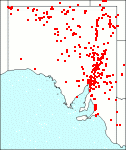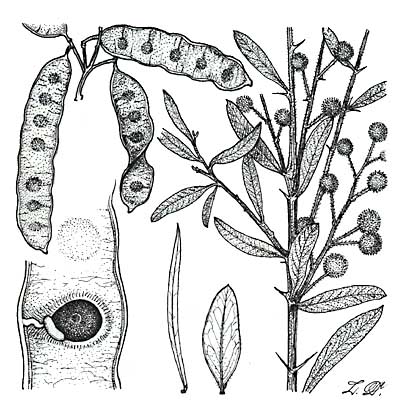Family: Fabaceae
Acacia victoriae

Citation:
G. Bentham in Mitch., J. Exped. Trop. Aust. 333(1848).
Derivation: victoriae—refers to the Victoria River or upper Barcoo in Qld where the type was collected.
Synonymy: A. sentis F. Muell., Pl. lndig. Colon. Vic. 2:18 (1863). Racosperma victoriae (Benth.)Pedley, Bot. J. Linn. Soc. (London) 92:249 (1986) Acacia decora var. spinescens Benth. Linnaea 26:620 (1855), Acacia coronalis J. Black, Trans. Roy. Soc. S. Aust. 71:20(1947).
Common name: elegant wattle, bramble wattle
Description:
Tall dense, thorny, much branched shrubs 2-5 m high; branchlets nearly terete, striate glabrous or pubescent when young; bark smooth, but slightly fissured at the base, yellowish-green to grey.
Phyllodes variable, lanceolate-oblong, linear to broad-linear or more or less elliptical, straight or falcate, 2-5 cm long, 3-8 mm broad, flat glaucous to light green, 1 prominent central vein and inconspicuous lateral veins, apex acute or obtuse with a short straight or recurved mucro. Glands small near base. Stipules frequent, rigid subulate spiny.
Inflorescences axillary, Peduncles solitary or mostly twin or along elongated raceme axes; flower-heads globular, pale creamy yellow, c. 30-flowered; peduncles slender hoary, 6-15 mm long; flowers 5-merous (sepals free).
Legumes thin and papery, flattish, yellowish-green becoming light brown when mature, 4-8 cm long, 10-13 mm broad, surfaces usually showing the outline of the seed; margins slightly thickened, usually with some constrictions. Seeds transverse in legume almost globular; funicle short, thickened into a small aril.
|
|
Distribution:
|
Widespread from near Adelaide through the Northern Lofty and Flinders Ranges regions in tall and low woodland on rocky hillsides, ridges and flats then extending to the Far North in the North-Western and Lake Eyre regions, associated with low shrubland and hummock grassland. There are a few isolated patches, one around Cook in the Nullarbor region and the other on the south coast near the Bluff at Victor Harbor. Soils; mainly brown calcareous earths, shallow calcareous loamy, crusty alkaline and neutral red duplex soils. Rainfall 125-500 ram. Also W. Aust., N.T., Qld, N.S.W. and Vic.
|
Flowering time: August — December.
|

SA Distribution Map based
on current data relating to
specimens held in the
State Herbarium of South Australia
|
Biology:
No text
Related taxa:
Acacia victoriae ssp. arida Pedley was described in Austrobaileya 1:271 (1979). It is distinguished from the type by its soft spreading hairs 0.2-0.3 mm long. Some of these specimens have much broader penniveined phyllodes but are very variable. Pedley also claimed there is some ecological separation. A number of South Australian collections have been so named but as many intermediates occur its distinction in South Australia needs more study. When plotted most of the collections so identified are north and east of Lake Eyre.
Taxonomic notes:
Grice & Westoby (1987) studied the seed banks and survival of A. victoriae at Fowlers Gap in western New South Wales. They showed that the seed bank in the soil was from 50 to 3900 seeds per square metre. Seedling density after emergence may reach 26 per square metre but this usually represented only a small percentage (less than 6%) of the total seed bank. However seedling death rate was high approaching 100% 12 months after germination. This suggests that if establishment is intermittent it is most likely due to low seedling survival rather than infrequent germination.
No fewer than six mistletoes have been recorded on A. victoriae in South Australia. The most common is Lysiana exocarpi harlequin mistletoe and a single record of L. murrayi mulga mistletoe. Almost as common as the first is Amyema preissii wire-leaved mistletoe with 1-2 records each ofA. quandang grey-leaved mistletoe, A. maidenii pale-leaved mistletoe and one only of A. hilliana.
Davies (1976, 1978) indicates that A. victoriae seeds were of some importance in the diet of emus in Western Australia.
Shurcliff (1980) indicates that the seed of A. victoriae was eaten by birds in the far north-west of South Australia but does not say which species are involved.
A. victoriae is the food plant for the larvae of several butterflies including Jalmenus icilius, J. lithochroa, Nacaduba biocellata and Theclinesthes miskini, Fisher (1978). A. victoriae was considered to have potential as a fodder tree in other arid areas of the world, Anon (1979). However no examples of its successful use are given.
A. victoriae can regenerate from suckers and may at times form dense thickets.
Cultivation:
Useful for planting in the dry inland areas as a low shelter belt or for soil stabilisation. Moderate to fast growth rate.
Author:
Not yet available
Source:

|

